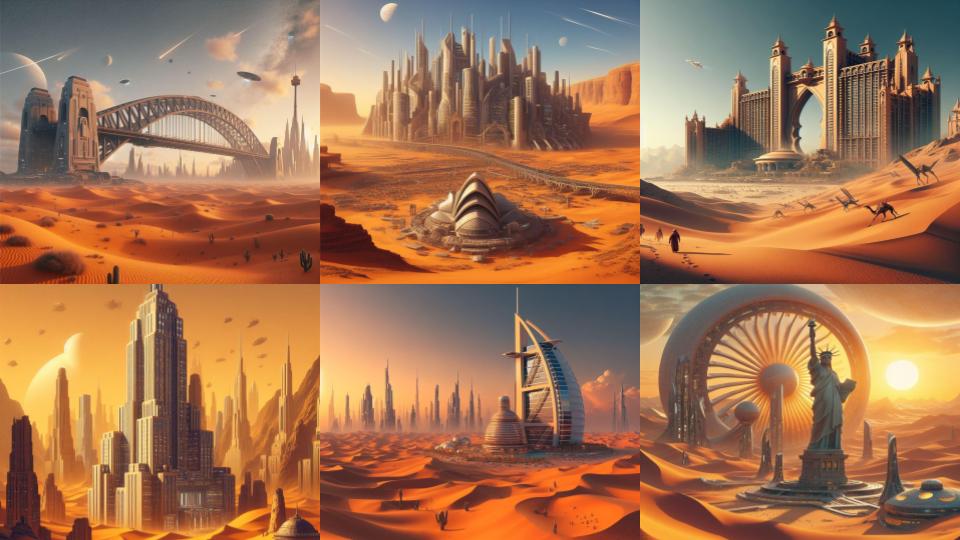Building on the momentum that it generated in its blockbuster opening weekend, Dune: Part Two, is already reaching massive box office milestones surpassing $150million. Over on TikTok, 'Dune Movie' gets around 200,000 searches a month, with 'New Dune Movie' increasing in searches by 4,606% in just 30 days. In the past month, searches around the movie including its filming location have spiked 141% on TikTok and 102% on Google.
Known for its amazing cinematography and striking desert visuals, the movie's landscape is something that makes it instantly recognizable. But the vast deserts of Arrakis, the fictional planet at the heart of Dune, are more than just a stunning backdrop. They serve as a stark warning of a potential future for our own world impacted by climate change.
Jump to City:
The Growing Threat of Desertification
Desertification, the transformation of fertile land into desert, is a pressing issue. The United Nations warns it threatens the livelihoods of over 3.2 billion people globally. Google search trends highlight a growing concern, with searches for "when does climate change turn violent?" surging 2,000% in the past year. Over on TikTok, searches for 'climate crisis 2024' have spiked 3,100% in 30 days.
What is Desertification?
The United Nations defines desertification as the degradation of fertile land in dry regions due to climate and human factors. This once slow process is accelerating and is now considered a major environmental problem.
A Glimpse of Our Desertified Future: Lessons from Dune
Climate change, unsustainable land management practices, and overpopulation are all contributing factors to desertification on Earth. We see echoes of Arrakis in shrinking lakes, dust storms swallowing once-fertile lands, and mass migrations driven by environmental degradation.
Around the world, desertification is severely impacting western America, where once vibrant landscapes are succumbing to drought, threatening entire ecosystems. Cities such as Las Vegas, Albuquerque, Chihuahua, El Salvador and El Calafate are extremely affected and have potentially reached a point of no return.
In Europe, Spain is the country most at risk of desertification. More than 75% of the country's territory is in the high vulnerability category, with one-fifth of the country infertile and already suffering from desertification.
Africa faces a major challenge as the Sahara Desert expands southward. Droughts are becoming more frequent in the Sahel region, jeopardizing the future of countless communities.
Eastern Brazil suffers from desertification partly due to deforestation. The arid regions of South Africa, Namibia, and Botswana are also witnessing growth of desert landscapes.
From Las Vegas to Dubai, we at Top10casinos.ca have used AI tools to visualize the cities most at risk of desertification as if they were in the Dune universe
Cities At Risk: A Glimpse into a Desertified Future
Las Vegas, Nevada
Across Nevada, people are starting to feel the effects of the climate crisis, with the state warming about 2.8°F on average since 1970. According to Climate Central, average summertime temperatures in Las Vegas have increased by 5.8°C over the last half century, ranking as the second fastest-warming city in the U.S, below Reno.



New York City, New York State
The Big Apple faces a scorching future. Data shows the city, already hit by droughts every 2-3 years, could see temperatures jump 4.7°C (8.4°F) by the 2030s - nearly double the historical warming rate. This, coupled with more frequent and intense droughts, paints a grim picture: a hotter, drier New York with potential water shortages, agricultural issues, and public health risks.



Dubai, United Arab Emirates
Rising desertification threatens ecosystems and food supply in Dubai where 80% of the country is already desert, with no natural primary forests. In 2010, the One Million Trees initiative was launched to increase green areas in Dubai through afforestation. At its peak, the tree nursery spanned more than 130,000 sq meters, however, according to nursery workers, close to 80% of the trees planted there have died due to unmanageable environmental conditions caused by global warming.



Barcelona, Spain
According to the UN Convention to Combat Desertification, 75% of Spain's land is battling climatic conditions that could lead to desertification, making it the European nation most threatened by the problem. In the next 10 years, the Spanish city Barcelona faces increasing risk from extreme heat, reduced water availability, more flooding and shrinking beaches and coastal protection due to sea level rises.


Madrid, Spain
A new Swiss study warns Madrid faces a scorching future. Unchecked emissions could push the city's climate towards that of present-day Marrakesh by 2050. This dramatic shift from hot summers and cool winters to a permanently hot and dry climate raises concerns about Madrid's long-term sustainability and its residents' way of life.


Sydney, Australia
Sydney's summers are getting hotter, and the future looks even sweatier. Over the past 30 years, global warming has pushed Sydney's average summer temperatures upwards. If we don't cut emissions and climate change continues on its current trajectory, a scorching future awaits. By 2100, summer temperatures could surge by a significant 2.6°C, transforming Sydney's climate into something more akin to present-day Papua New Guinea.



Canada's Changing Climate: What Key Cities Could Look Like With 'Dune-Ification'
Canada's iconic outdoor skating rinks face a frosty future. While bundling up for harsh winters is a national pastime, a worrying trend is emerging. Since 1950, winter temperatures have soared by over 3°C, outpacing global warming by a factor of three.
Toronto, Ontario
Toronto, once known for its predictable seasons, is grappling with the impacts of climate change. The city is experiencing a rise in average temperatures, leading to more frequent and intense heat waves that strain infrastructure and threaten public health. Winters are becoming shorter and less severe, with unpredictable precipitation patterns bringing both heavier downpours that overwhelm storm drains and periods of drought that stress green spaces and water resources.

Vancouver. British Columbia
Like many coastal, seaport cities, Vancouver is feeling the brunt of climate change. Rising temperatures are a key concern, with projections for hotter, drier summers and wetter winters. Sea levels are also on the rise, threatening coastal areas with flooding. The City of Vancouver itself is planning for up to a 1.4 meter rise by 2100, which would inundate parts of the city during major storms.

Montreal, Quebec
Montreal's climate is expected to experience significant changes due to climate change. Average temperatures are projected to rise by 1.5-2.3°C by mid-century, leading to more frequent and intense heat waves. This can strain infrastructure, harm public health, and disrupt outdoor activities. The city is also likely to see increased precipitation extremes, with heavier rainfall events and the potential for more flooding.


Niagara Falls, Ontario
Studies suggest Lakes Erie and Ontario, feeding the Niagara River, could see water levels drop a meter by 2050 due to increased evaporation and less snowfall. This decline could impact the Falls' power and beauty. Additionally, more extreme weather events like flooding could damage surrounding areas. While milder winters might extend tourism, climate change poses significant ecological and aesthetic challenges.

Methodology
- We researched cities most at risk of desertification using: https://www.tomorrow.city/cities-at-risk-from-desertification/.
- We then input these cities into Bing's Image Creator AI generation tool using a specific prompt to make the images look like a Dune landscape.
- Search volumes and trends were gathered using https://keywordtool.io/.

